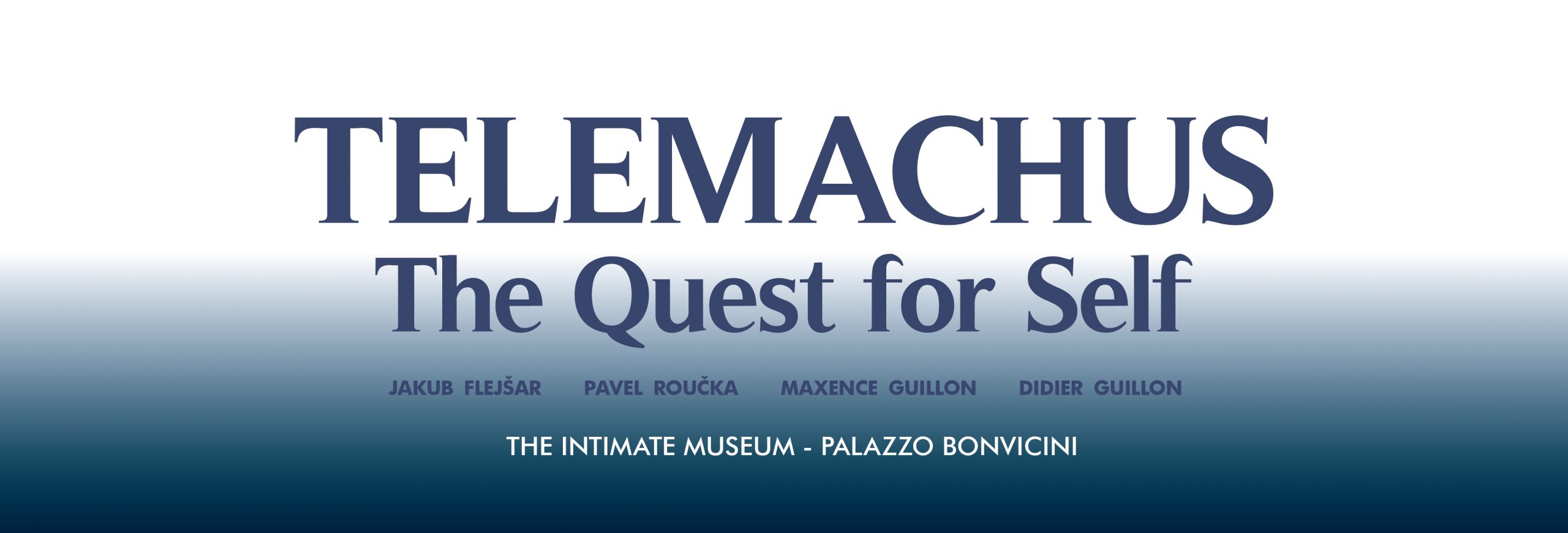
TELEMACHUS. The Quest for Self marks the second chapter of a trilogy of contemporary art exhibitions inspired by Homer’s Odyssey. This chapter delves into the character of Telemachus, exploring the father-son relationship from the perspectives of both Telemachus and Ulysses. Featuring four artists — Jakub Flejšar, Pavel Roučka, Maxence Guillon, and Didier Guillon — the exhibition presents a deeply personal and intergenerational dialogue, reflecting the relationship between father and son through two distinct pairs.
EMANCIPATION, UPHEAVAL, INTROSPECTION, HERITAGE
The exhibition weaves together themes of self-discovery, legacy, and transformation as Telemachus embarks on his journey to find his father and uncover his own identity. The works engage in a dialogue between the mythical past and the present, exploring how familial bonds shape the way we understand ourselves.
The first adjective that comes to mind to describe TELEMACHUS. The Quest for Self is monumental. The rooms at Palazzo Bonvicini are filled to the very last centimeter with powerful yet intimate installations, mesmerizing visitors on their journey of discovery. Each artist loudly affirms their presence through sculptures, paintings and installations that will undoubtedly leave a lasting impression. Indeed, the exhibition narrates the father-son relationship – with all its fragilities, complexities, complicities, and synergies – in a manner that is monumental and introspective.
With Flejšar and Roučka, the rooms merge with one another, reflecting an intrinsic and indispensable personal and artistic relationship. The boundaries blur, with the artists’ identities clearly defined yet in tension with each other. The focus shifts inward with the Guillon, prompting the artists to contemplate both what they have become and what they are becoming, with their gaze directed towards both the past and the future of generations.

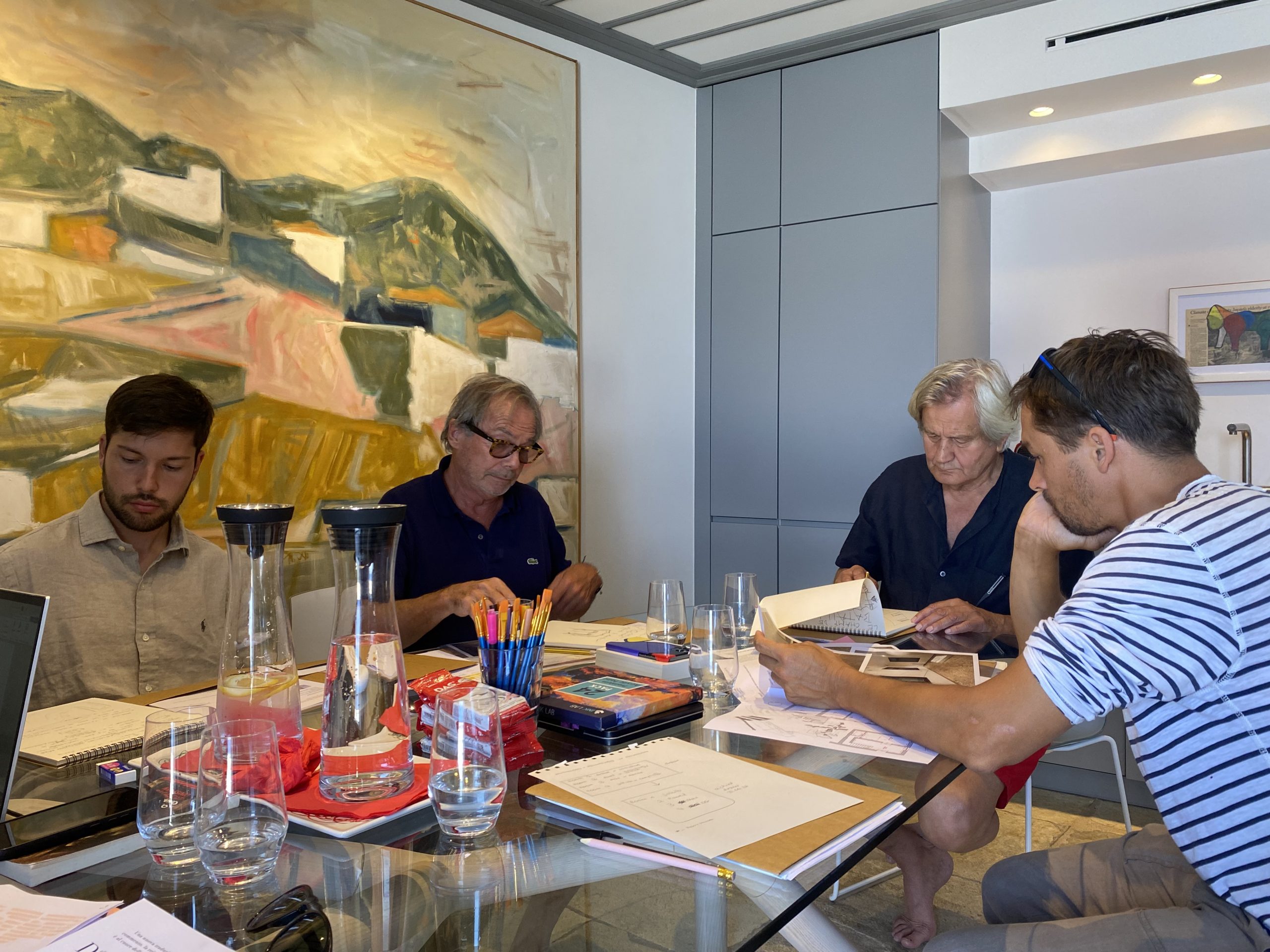
Left to right: Maxence Guillon, Didier Guillon, Pavel Roučka,
Jakub Flejšar, Workshop in the Villa Valentine – Hydra, June 2024
Location
Fondation Valmont
Palazzo Bonvicini
Santa Croce, Calle Agnello, 2161/A
30135 Venezia VE, Italy
Open every day,
10.00 am to 6.00 pm
free entry
info@fondationvalmont.com
COMPLICITY
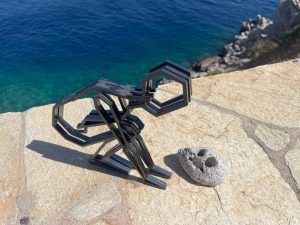
For the first time at Palazzo Bonvicini, rooms are metaphorically and physically intertwined to represent Jakub Flejšar’s and Pavel Roučka’s profound familial bond from a 360-degree perspective. Flejšar synthesizes this bond by placing a giant red steel sculpture between his room and Roučka’s: a seated man, the artist himself, viscerally penetrates the space. This arrangement allows the visitor to discover, in Room 1, just a part of the whole. In the middle of the room, a large human figure is crouched down, gazing at the seated man, seemingly burdened by an inheritance too heavy to bear.
The two sculptures are portraits of the artist at different stages of his life: before and after mastering the ability to maintain his complicity with Roučka without slipping into dependency. Complicity is a key concept in the Odyssey after all, as Telemachus plays a pivotal role in Ulysses’ attempt to reclaim power in Ithaca.
The crossing sculpture enters Roučka’s space which is imbued with the intensity of gesture and imposing paintings. Champ de Bataille unfolds as a moment of confrontation: Flejšar’s seated man, situated between the two rooms, deliberately turns his back on his stepfather’s paintings, preparing to make a bold decision. Though he understands his paternal figure’s work, he is finally ready to forge his own path.
CHAMP DE BATAILLE
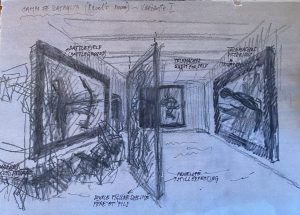
At the centre of Room 2, two large paintings depict the key figures in Ithaca: Penelope, still and silent in the front like an observing matriarch; Telemachus with Ulysses in the back, merging into a single entity – coinciding, sublimated, almost indistinguishable. This fusion raises a striking question: can the son ever truly break free, or is he destined to carry his father’s legacy forever? This duality is at the heart of Champ de Bataille – a revolutionary battlefield in transformation.
Flanking this central vision, a series of scenes unfold like a protective embrace in Room 2. Telemachus appears in different stages of his journey – fighting, questioning himself, and ultimately triumphing. Father and son cannot stand as rivals but as figures entwined in the same struggle, navigating the fine line between lineage and self-determination.
THE VIRTUOUS CIRCLE
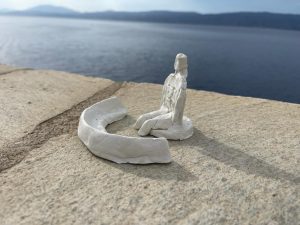
In Room 3 Maxence Guillon’s installation The Virtuous Circle explores his journey as both a man and a son, following in the footsteps of his father, Didier Guillon. This path is initially represented by a red carpet, symbolizing the invisible presence of the artist, guided and protected by his father. As the carpet turns to a brownish tone, the scene shifts to a contemporary arena, where a multimedia installation replaces the physical presence of ancient Roman spectators. In front of the towering arena, a classic-style sculpture with Maxence’s features performs like a gladiator.
The digital presence of Didier Guillon silently judges his son’s performance — eternally watching from his ever-present/absent televised form. If Didier Guillon replaces the physical spectators of ancient Rome, actual visitors are invited to sit in front of Maxence on a special seat, taking on the role of his father. Maxence’s journey, such as Telemachus’ journey, mirrors the universal human experience of navigating an adventure made possible only through the awareness of his father’s heritage.
EN DESSOUS DES RÊVES
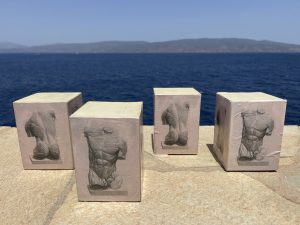
For Room 4, Didier Guillon has chosen to present two anatomical drawings of his great-great-grandfather, Alphonse Lami, printed on towering, monolithic totems that stand as monumental echoes of the past. These sculptures anchor the works in the present, linking several generations across time. Above these totems, the word dream glows in luminous, incandescent letters, translated into ten different languages. This universal term transcends linguistic and cultural barriers, embodying the shared human experience of aspiration and courage.
The installation En dessous des rêves invites us to reflect on the essential role of dreams in shaping our future. Without dreams, it becomes impossible to draw from the past the heritage needed to navigate the present and, above all, to gaze towards the unknown horizon.
As the final room of the exhibition, this space closes the virtuous circle, inviting the viewer to reflect on how heritage shapes not only the past but also the future. Much like Telemachus’ journey reaching its conclusion, this room serves as a culmination, uniting the themes of legacy, transformation, and self-discovery. It leaves the viewer with a sense of resolution and potential.
